Foot Orthotic Insoles Market Research, 2031
The global foot orthotic insoles market size was valued at $3.2 billion in 2021 and is projected to reach $5.7 billion by 2031, growing at a CAGR of 6.4% from 2022 to 2031. The Foot orthotic insoles are a type of medical device that is used to reduce pain in the foot and provide comfort by wearing it in shoes. They are able to provide arch support, improve overpronation, and be used to correct the way of standing and walking. They can be used to treat plantar fasciitis and other painful foot and postural conditions. Foot orthotic insoles improve muscular activity and performance while also lowering the risk of soft tissue injuries brought on by stress, strain, or stretching, which can result in mechanical damage to the soft tissues of the athlete. The foot orthotic insoles have various applications which include sports & athletics, medical, and personal comfort.
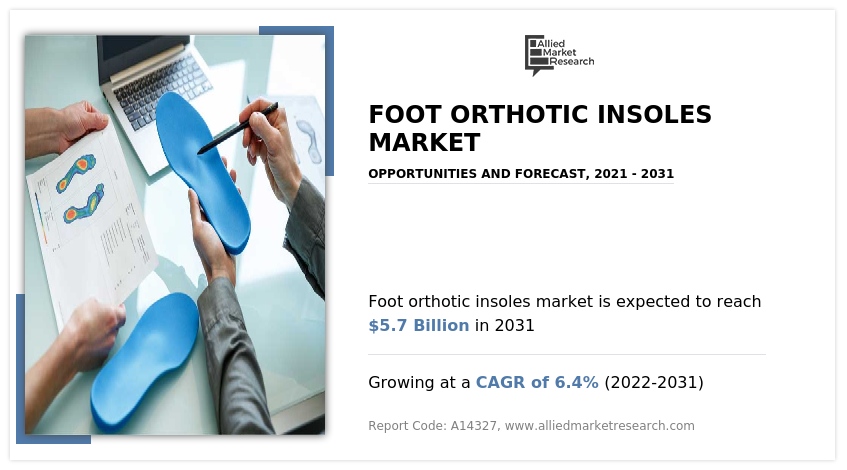
Historical Overview
The foot orthotic insoles market size was analyzed qualitatively and quantitatively from 2018-2020. Most of the growth during this period was derived from Asia-Pacific owing to the increase in the incidence of foot pain, increase in the prevalence of diabetes, rise in disposable incomes, as well as the well-established presence of domestic companies in the region.
Market Dynamics
The foot orthotic insoles market share has witnessed growth, owing to an increase in foot diseases including clubfoot, bunions, hammertoes, mallet toes, and claw toes, which drive the growth of the foot orthotic insoles market share. For instance, according to Orthopedic Associates 2022 update, 60 million Americans, or 25% of the U.S. population have flat feet. According to Cleveland Clinic, all babies have flat feet at birth and arches typically form by age 6. But, about 2 out of 10 children still have flat feet as adults.
In addition, the suitably designed orthotic insoles are proven to reduce forefoot plantar pressures in patients at risk of plantar ulceration, thereby, the rise in the prevalence of diabetes boosts the growth of the foot orthotic insoles market. For instance, according to the American Diabetes Association, 37.3 million Americans had diabetes (11.3% of the U.S. population) in which nearly 1.9 million Americans have type 1 diabetes, including about 244,000 children and adolescents.
Furthermore, the rise in the geriatric population is another key factor that is projected to drive the growth of the foot orthotic insoles market. The muscles and ligaments in the foot become weaker with the increase in age, as do the bones due to calcium reduction. In addition, the fatty padding under the foot thins out, which means less protection and cushioning for the bones, in particular the heel bone. For instance, according to WHO in 2020, it was estimated that about 727 million persons aged 65 years or over worldwide. This number is projected to more than double by 2050, reaching over 1.5 billion people. According to a review article “Achilles Tendonitis” of the National Center for Biotechnology Information, published in 2022, the aging population has a considerable risk of rupture of the Achilles tendon and is more vulnerable to tendinitis.
Moreover, the foot orthotic insoles improve sports performance, prevent harm, or lessen the severity of injury during practice or competition and help the recovery of existing injuries. These are widely adopted by sportspersons & athletes which boosts the growth of the foot orthotic insoles market. For instance, according to Superfeet company, carbon fiber insoles are best used in sports that have a lot of impact and movement, such as running, hiking, walking, and hockey. A rise in the number of sports activities and an increase in the number of sportspersons and athletes thus drive the growth of the foot orthotic insoles market. For instance, according to the Statista report, published in December 2022, the number of people participating in sport twice a month in England in 2021, by activity group.
COVID-19 has negatively affected the orthopedics field by which doctors are not adequately concentrating on their regular patients. There is a shortage of doctors and support staff, and this pandemic impacted all the necessary activities for the sales of foot orthotic insoles, with the pandemic. Researchers identify an alarming shortage of critical orthopedics devices. According to the review article “Effects of COVID-19 pandemic in the field of orthopedics” of National Library Medicine, published in 2020, performing orthopedics surgery has become a significant challenge with the non-availability of hospital staff and operation facilities during COVID-19. It has a significant effect on the manufacturing of orthopedic devices including foot orthotic insoles, tools, instruments, and routine ongoing research and development.
However, the foot orthotic insoles market witnessed an incline in the sales of foot orthotic insoles in the fiscal year of 2021. This increase in revenues is associated with a relaxation in lockdowns and a decline in COVID-19 cases, resuming orthotic appointments. The companies have restarted their processes to meet the demand for products.
Furthermore, a rise in technological advancement, an increase in the initiative taken by the government, a rise in the adoption of customized orthotic insoles to reduce pain, significant rise in the geriatric population is expected to witness the growth of the foot orthotic insoles market during the forecast period. For instance, in July 2022, Northwest Podiatric Laboratory makes prescribing life-changing orthotics easier than ever with a recent update to its SmartCast app that introduces the ability to scan patients using iPad Pro and iPhone models with Face ID. In addition, the prevalence of diabetes further led to foot ulcers, and an increase in health issues associated with a rise in the incidence of foot pain is anticipated to increase the demand for foot orthotic insoles and boost the growth of the market. Thus, such trends are expected to bring stabilization in the foot orthotic insoles market, and subsequently witness a growth rate during the forecast period.
Segmental Overview
The foot orthotic insoles market is segmented on the basis of material, application, distribution channel, and region. On the basis of material, the market is classified into thermoplastics, ethyl-vinyl acetate (EVA), foams, composite carbon fibers, and others. On the basis of application, the market is classified into sports & athletics, medical, and personal comfort. On the basis of distribution channels, it is fragmented into hospital pharmacies, retail stores, and online stores. On the basis of region, the foot orthotic insoles market is analyzed across North America (the U.S., Canada, and Mexico), Europe (Germany, France, the UK, Italy, Spain, and the Rest of Europe), Asia-Pacific (China, Japan, Australia, India, and Rest of Asia-Pacific), and LAMEA (Brazil, South Africa, Saudi Arabia, and Rest of LAMEA).
By Material
On the basis of material, the foot orthotic insoles market is segmented into thermoplastics, ethyl-vinyl acetate (EVA), foams, composite carbon fibers, and others. The ethyl-vinyl acetate (EVA) segment generated maximum revenue in 2021 and is expected to witness the highest CAGR during the forecast period, owing to the high adoption of ethyl-vinyl acetate for the manufacturing of foot orthotic insoles and the increase in the prevalence of foot deformities and foot pain. In addition, the rise in the geriatric population that is vulnerable to rheumatoid arthritis has propelled the growth of the ethyl-vinyl acetate segment.
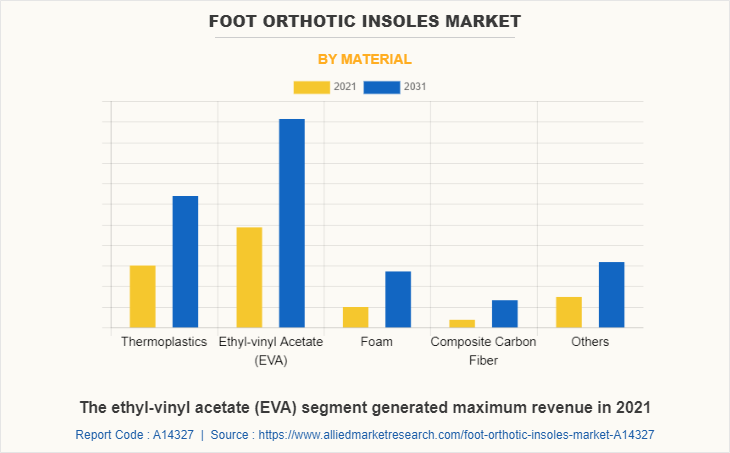
By Application
On the basis of application, the foot orthotic insoles market is segregated into sports & athletics, medical, and personal comfort. The medical segment generated maximum revenue in 2021, owing to an increase in the prevalence of foot diseases including clubfoot, bunions, hammertoes, and mallet toes, and an increase in the incidence of plantar fasciitis, calcaneal spur, Achilles tendinitis. The personal comfort segment is expected to witness the highest CAGR during the forecast period, owing to a rise in disposable income and a rise in awareness regarding health benefits from the use of foot orthotic insoles.
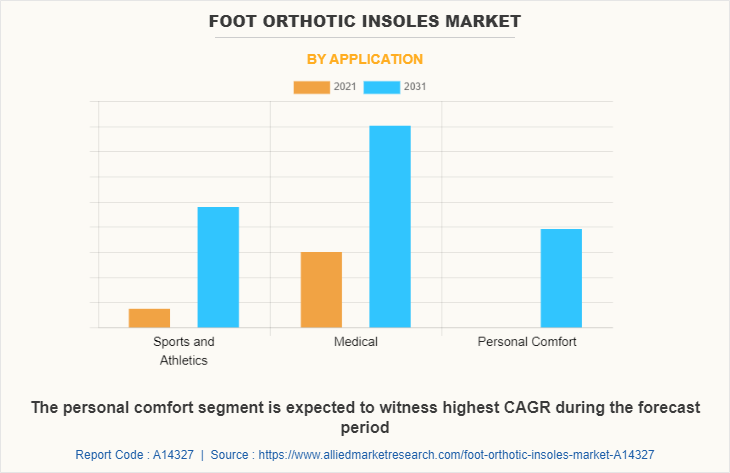
By Distribution Channel
On the basis of the distribution channel, the foot orthotic insoles market is classified into hospital pharmacies, retail stores, and online stores. The retail store's segment was the highest revenue contributor to the market in 2021, owing to an increase in demand for foot orthotic insoles, and an increase in the number of retail stores. The online store segment is expected to witness the highest CAGR during the forecast period, owing to various advantages such as more convenience, fewer expenses, easy access to patient reviews, and price comparisons.
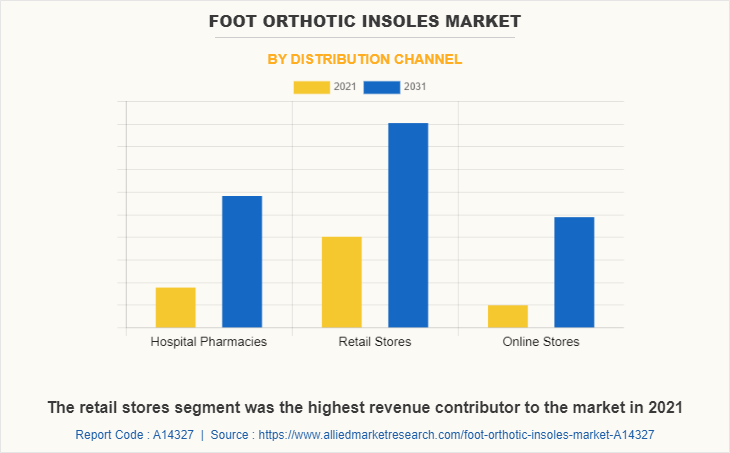
By Region
On the basis of region, the foot orthotic insoles market is studied across North America, Europe, Asia-Pacific, and LAMEA. North America accounted for a major share of the market in 2021 and is expected to maintain its dominance during the forecast period. The presence of several major players, such as Acor Orthopaedic, Inc., Aetrex Inc., Hanger Inc., Implus Footcare LLC, and Superfeet Worldwide, LLC, and advancement in manufacturing technology of foot orthotic insoles in the region drive the growth of the market. Furthermore, the rise in the number of aged individuals who are highly susceptible to chronic heart diseases, cancer, and the existence of a sophisticated reimbursement structure that aims to reduce expenditure levels, drives the growth of the foot orthotic insoles market. Hence, such factors propel market growth. In addition, the U.S. is anticipated to contribute to a major share of the regional market and is expected to drive the growth of the foot orthotic insoles industry throughout the forecast period. The presence of well-established healthcare infrastructure, high purchasing power, and a rise in the adoption rate of foot orthotic insoles are expected to drive market growth.
Asia-Pacific is expected to grow at the highest rate during the foot orthotic insoles market forecast period. The foot orthotic insoles market growth in this region is attributed to rising prevalence of foot disease, the prevalence of diabetes and chronic orthopedic disorders such as osteoarthritis, rheumatoid arthritis, and acute backache, increase in the number of people across the globe dealing with foot problems such as plantar fasciitis, bursitis, bunions, and heel spurs.
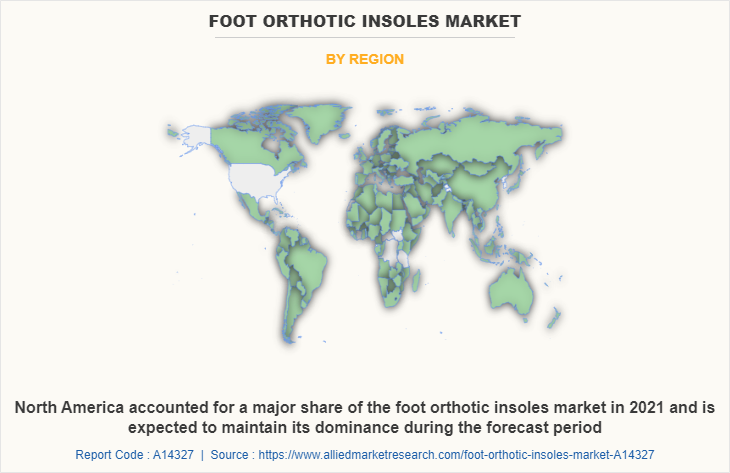
Competitive Analysis
Competitive analysis and profiles of the major players in the foot orthotic insoles market, such as A. Algeo Ltd., Acor Orthopaedic, Inc., Aetrex Inc., Bauerfeind, Digital Orthotics Laboratories Australia Pty Ltd, Foot Science International, FootBalance System Ltd, Superfeet Worldwide, Llc, Thuasne, Tynorindia are provided in this report.
There are some important players in the market such as Digital Orthotics Laboratories Australia Pty Ltd have adopted innovation as a key developmental strategy to improve the product portfolio of the foot orthotic insoles market.
Some examples of innovation in the market
In February 2022, Digital Orthotics Laboratories Australia Pty Ltd launched the DOLA iPhone scanning Guide. The scanning feature provides easy scanning of feet & foam impression boxes and has various characteristics including attaching clinical photos and clinical notes, and instant 1 touch orthotic ordering; therefore, the customer can scan, prescribe, and order orthotics using iPhone.
Key Benefits for Stakeholders
- This report provides a quantitative analysis of the market segments, current trends, estimations, and dynamics of the foot orthotic insoles market analysis from 2021 to 2031 to identify the prevailing foot orthotic insoles market opportunity.
- Market research is offered along with information related to key drivers, restraints, and opportunities.
- Porter's five forces analysis highlights the potency of buyers and suppliers to enable stakeholders to make profit-oriented business decisions and strengthen their supplier-buyer network.
- An in-depth analysis of the foot orthotic insoles industry segmentation assists to determine the prevailing market opportunities.
- Major countries in each region are mapped according to their revenue contribution to the global market.
- Market player positioning facilitates benchmarking and provides a clear understanding of the present position of the market players.
- The report includes analysis of the regional as well as global foot orthotic insoles market trends, key players, market segments, application areas, and market growth strategies.
Foot Orthotic Insoles Market Report Highlights
| Aspects | Details |
| Market Size By 2031 | USD 5.7 billion |
| Growth Rate | CAGR of 6.4% |
| Forecast period | 2021 - 2031 |
| Report Pages | 350 |
| By Material |
|
| By Application |
|
| By Distribution Channel |
|
| By Region |
|
| Key Market Players | A. Algeo Ltd., Footbalance System Ltd., Bauerfeind, Digital Orthotics Laboratories Australia Pty Ltd, Tynorindia, Superfeet Worldwide, Llc, Foot Science International, Thuasne, Aetrex Inc., Acor Orthopaedic, Inc. |
Analyst Review
According to CXOs, the foot orthotic insoles market has witnessed growth, owing to the high prevalence of bunions, claw toes, hammer toes, rheumatoid arthritis (affects the lining of the joints, causing them to become thickened and painful), and the availability of various foot orthotic insoles devices.
Moreover, technological advancements such as 3D footprinting techniques, the rise in the prevalence of obesity, a geriatric population that is vulnerable to foot pain, and propels the growth of the foot orthotic insoles market. Furthermore, the increase in demand for foot orthotic insoles by sportspersons and athletes boosts the growth of this market. The rise in the prevalence of diabetes that further led to foot ulcers has increased the demand for specially designed foot orthotic insoles worldwide and contributed to the growth of this market.
North America is expected to witness the highest growth, in terms of revenue, owing to an increase in cases of foot pain and deformities, robust healthcare infrastructure, presence of key players, and rise in healthcare expenditure. However, Asia-Pacific is anticipated to witness notable growth, owing to an increase in awareness related to the use of foot orthotic insoles to reduce pain and treat foot deformities, unmet medical demands, a high population base, and increase in public–private investments in the healthcare sector.
The ability to scan patients using iPad Pro and iPhone models with Face ID coupled with the prevalence of diabetes further led to foot ulcers are a few key trends in Foot Orthotic Insoles Market.
The medical segment generated maximum revenue in 2021, owing to an increase in the prevalence of foot diseases including clubfoot, bunions, hammertoes, and mallet toes, and an increase in the incidence of plantar fasciitis, calcaneal spur, Achilles tendinitis.
North America accounted for a major share of the foot orthotic insoles market in 2021 and is expected to maintain its dominance during the forecast period.
Lack of awareness and slightly higher cost might affect the market negatively during the forecast period
Yes
the rise in geriatric population and increase in foot related ailments such as clubfoot, bunions, hammertoes, and mallet toes are a few major drivers of the Foot Orthotic Insoles market
The foot orthotic insoles market was valued at $3,148.16 million in 2021 and is estimated to reach $5,741.00 million by 2031, exhibiting a CAGR of 6.4% from 2022 to 2031.
Aetrex Inc., Bauerfeind, SUPERFEET WORLDWIDE, LLC, and Foot Science International are a few major companies operating in the Foot Orthotic Insoles market
Loading Table Of Content...



